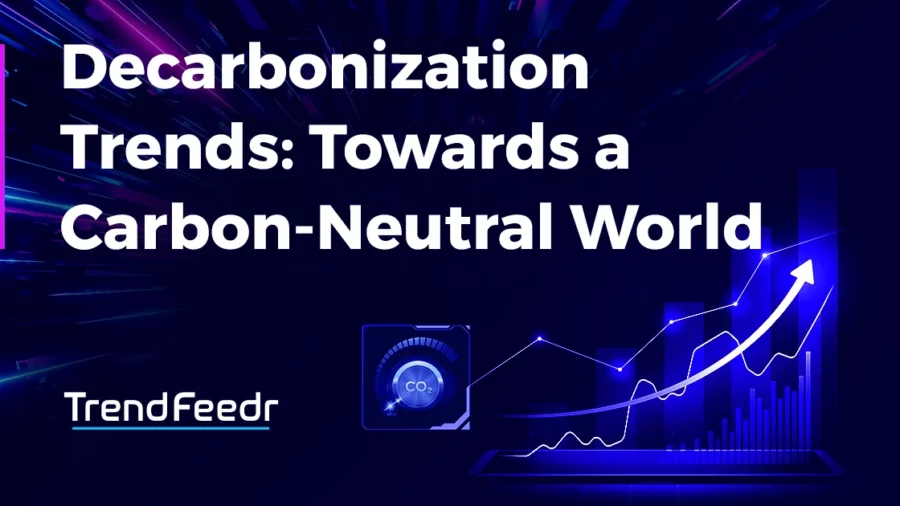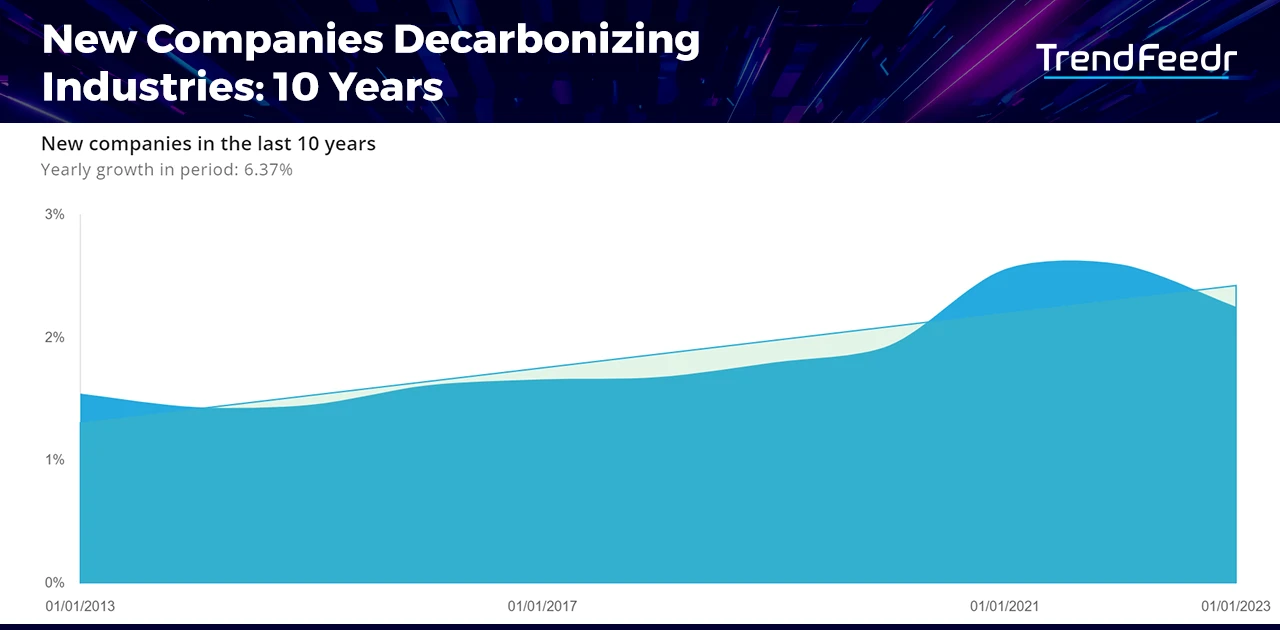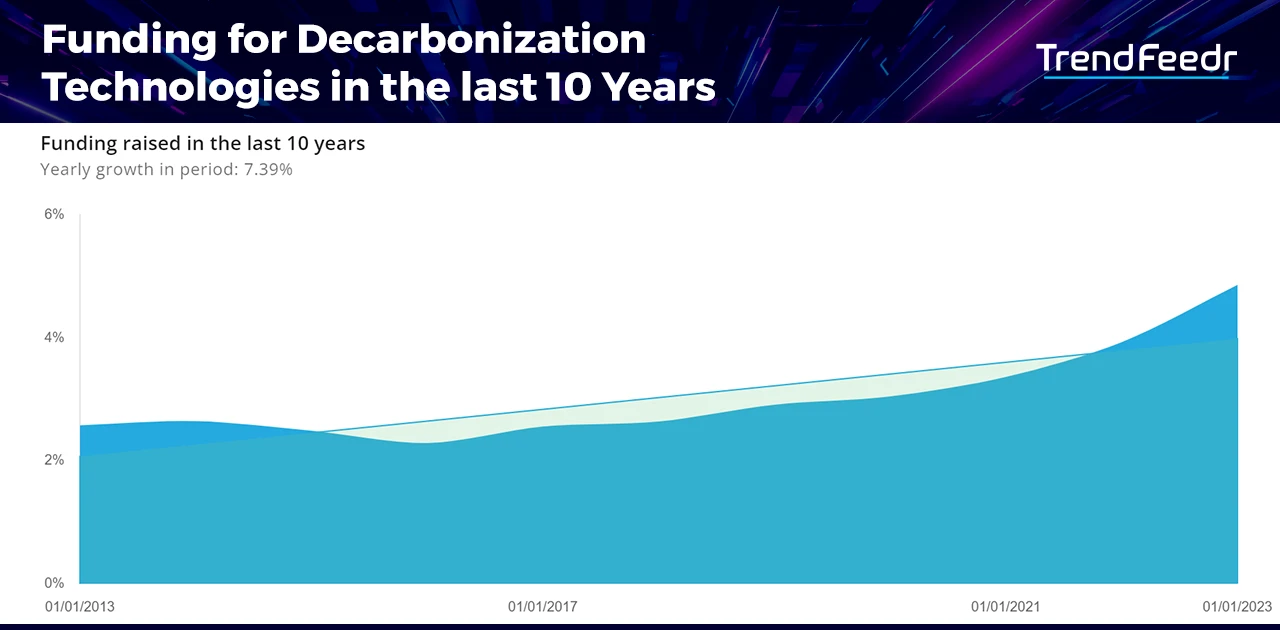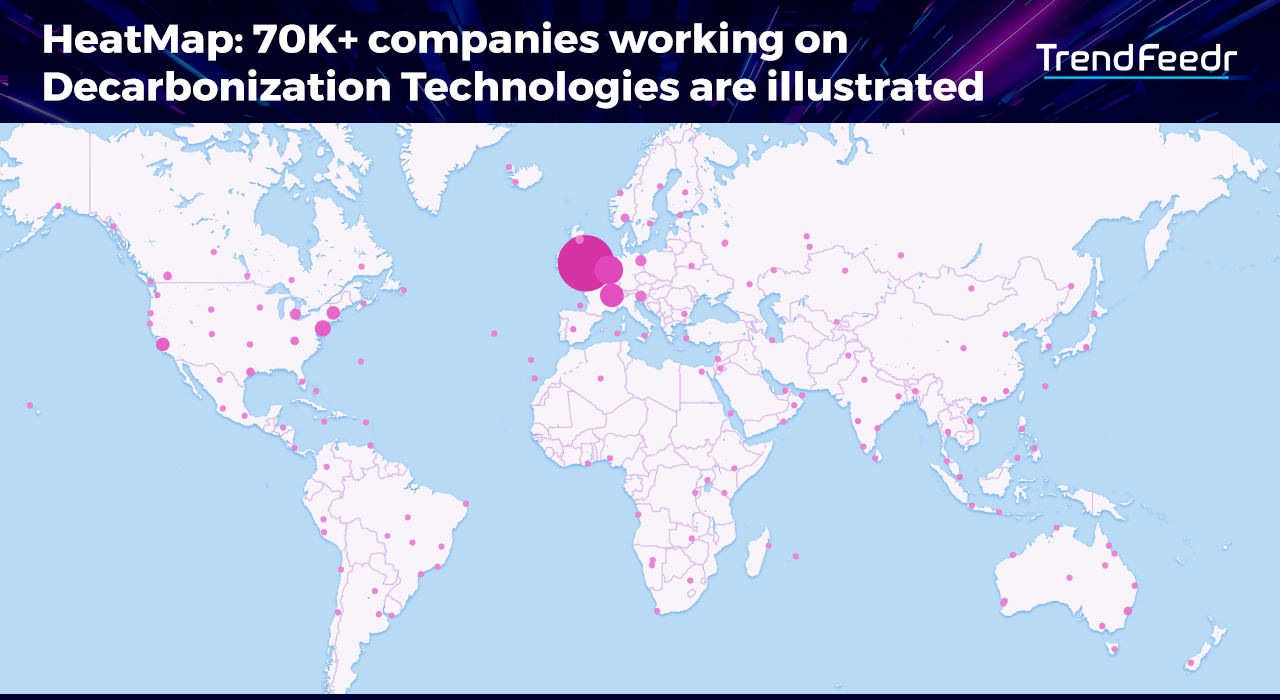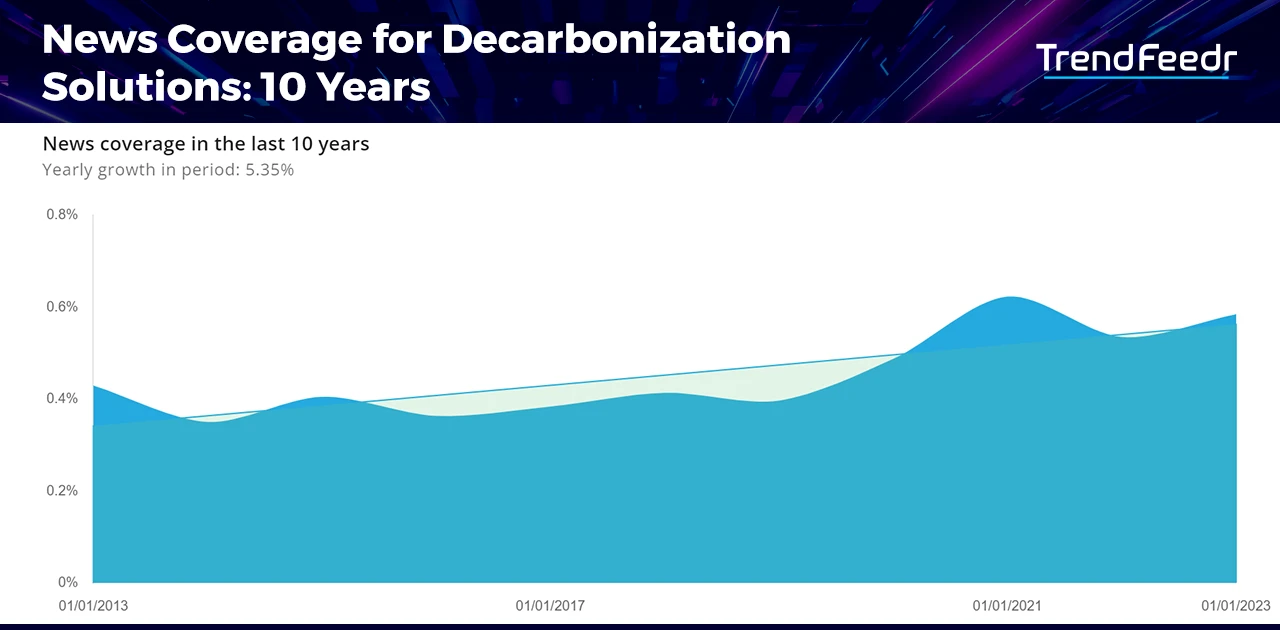Amidst swift global changes, we are noticing substantial transformations in several sectors driven by the global push towards decarbonization. The future will likely see electric vehicles outnumbering their gasoline counterparts and buildings powered predominantly by renewable energy. Further, restaurants will opt for locally sourced ingredients to reduce carbon emissions.
The urgency of this transition is underscored by the NOAA’s Global Monitoring Lab’s annual report of a record high of 417.06 ppm in global average atmospheric carbon dioxide in 2022. This alarming figure has galvanized industries and governments worldwide into collective action. The World Energy Transitions Outlook suggests that renewable sources could provide 65% of the world’s total electricity supply cost-effectively by 2030. This could lead to a potential 90% decarbonization of the power sector by 2050, marking a significant step towards mitigating climate change.
Understanding these trends of decarbonization goes beyond staying updated with data. It involves envisioning and aligning with a future that prioritizes sustainability, innovation, and proactive environmental stewardship.
Key Takeaways
- Pioneering Trend: Decarbonization, with a trend magnitude of 99.62% and maturity of 52.08%, is becoming a critical component in the global transition towards sustainable practices and technologies.
- Broadening Scope: Entities that already employ decarbonization are broadening their horizons to encompass related trends such as renewable energy, electrification, low-carbon technologies, carbon capture, utilization & storage (CCUS), and waste-to-energy.
- Robust Organizational Involvement: An estimated 70K+ organizations are actively engaged in the decarbonization sector, collectively drawing investment capital of approximately US$800 billion.
- Significant Financial Backers like Warburg Pincus, GIC, and EnCap Flatrock Midstream are leading the way, injecting billions into innovative decarbonization initiatives.
- Global Leaders in Adoption: Countries such as the United States, India, Australia, the United Kingdom, and China are at the forefront of decarbonization efforts. Further, cities like London, New York City, Houston, Sydney, and Melbourne, serve as hotspots for innovation and action in this crucial trend.
- Media’s Amplifying Role: The steady yearly increase of 5.35% in terms of media coverage over the past decade highlights the growing significance and relevance of decarbonization in global conversations.
Table of Contents
- Understanding Decarbonization Trends
- Decarbonization Performance Analysis
- Emerging Decarbonization Trends & How Companies are Advancing Them
- How Decarbonization Impacts Industries
- Rising Investing Interest in Decarbonization
- Regional Presence of Decarbonization Firms
- Future Outlook of Decarbonization
In this data-centric examination, we delve into the current trends in decarbonization with a spotlight on renewable energy, electrification, low-carbon technologies, carbon capture, utilization & storage, and waste-to-energy.
For this comprehensive analysis of decarbonization trends, we utilize TrendFeedr, our all-in-one trend intelligence platform. TrendFeedr employs advanced algorithms to identify future industry and tech trends. With an emphasis on trend discovery, comparison, and analysis, the AI-powered platform reviews thousands of trends each week and provides actionable insights.
Among the over 20,000 trends and technologies tracked by TrendFeedr, decarbonization has made a significant impact. Here’s why:
- Decarbonization ranks within the top 100 trends, placing it in the top 1% of global trends, thus underlining its substantial influence across various sectors.
- With a noteworthy trend maturity of 52.08%, decarbonization is spearheading a shift towards diminishing the levels of carbon dioxide (CO2) and carbon dioxide equivalents (CO2e) in the atmosphere.
- Factors like cost-effectiveness, economic opportunity, regulatory pressure, environmental urgency, and energy efficiency are catalyzing this transformation.
This decarbonization report explores various facets, including performance, investment, regional, and future trends.
Understanding Decarbonization Trends
Undoubtedly, decarbonization serves as a crucial approach to mitigating the detrimental impacts of climate change. It diminishes carbon intensity, thereby reducing the volume of greenhouse gas emissions generated by manufacturing or energy production processes.
What are the Trends in Decarbonization?
Decarbonization encompasses several sectors with the objective of significantly reducing carbon emissions. Notable trends within this endeavor include the transition to renewable energy. The global community is shifting towards renewable energy sources such as solar, wind, and hydroelectric power in an effort to lessen reliance on fossil fuels. In the transport sector, electric vehicles (EVs) and hybrid technology are leading the charge in decarbonization efforts. Rivian’s electric vehicles exemplify how electrification is aiding in the reduction of greenhouse gas emissions.
Additionally, innovative technologies for CCUS, one of the decarbonization methods, are being developed. They capture CO2 emissions at their source, followed by transportation and storage underground or utilization in some form. The Alberta Carbon Trunk Line Project (ACTL), which became fully operational in June 2020, is a prime example of how captured CO2 can be used for enhanced oil recovery.
Technological Innovations Propelling the Trend
The foundation of decarbonization is built on technological innovations that facilitate the capture, reduction, or elimination of CO2 emissions. Some key technologies include battery storage technology. These technologies are essential for effectively harnessing and utilizing renewable energy. For instance, advances in lithium-ion batteries have paved the way for superior energy storage solutions, thereby making renewable energy sources more dependable.
In addition, smart grids are instrumental in the efficient management and distribution of energy, a critical factor for seamlessly integrating renewable energy sources into the system. Denmark, for example, has been at the forefront of smart grid technology to optimally manage its wind energy resources. Further, the evolution of materials with lower embodied carbon and higher efficiency is a crucial aspect of decarbonization. The emergence of carbon-fiber reinforced concrete offers a lower-carbon alternative to traditional concrete.
Decarbonization Performance Analysis
Presenting the Decarbonization Trend Card, a concise summary of worldwide efforts towards minimizing carbon footprints. Explore key entities spearheading carbon-neutral initiatives, innovative technologies, and shifts in policy. Our examination underscores vital metrics such as decarbonization investments led by pioneers steering this green transition. Highlighting the cascading impacts across industries and regions, this card provides a glimpse of current advancements and narratives dominating the discourse. Understand the rate of advancement in the decarbonization sphere and the media’s role in heightening its significance.
With an annual growth rate of a robust 3.44%, there is a discernible acceleration in worldwide decarbonization endeavors. The trend magnitude, standing at an impressive 99.62%, demonstrates the vast scale and impact of this trend, indicating a transformative potential across sectors. Ranking within the top 100, decarbonization solidifies its position as a leading and influential trend, attracting attention from various stakeholders. Despite the significant advancements, the trend maturity metric of 52.08 suggests considerable scope for innovation and growth in the forthcoming years.
Looking for all trends related to decarbonization?
Emerging Decarbonization Trends & How Companies are Advancing Them
According to the latest data from TrendFeedr, 70,244 companies are focused on reducing climate impacts and advancing decarbonization trends. Let’s explore these trends in detail:
1. Renewable Energy
- Shifting to renewable energy includes leveraging natural resources such as the sun, wind, and water to generate power with a minimal carbon footprint.
- An impressive 83,237 organizations have embarked on this journey, collectively directing investments exceeding US$700B.
- With a strong workforce of 7.6 million professionals, this trend highlights the immense potential and dedication towards a sustainable future.
2. Electrification
- Electrification, the transition from fossil fuel-based systems to electric alternatives, is transforming sectors from transportation to heating.
- This movement has captured the interest of 5,904 organizations, collectively securing investments amounting to US$56.7B.
- With a specialized workforce of 773.2K, the momentum towards electrification is steadily increasing.
3. Low-Carbon Technologies
- Low-carbon technologies decrease carbon output across various applications, ensuring sustainability without compromising efficiency.
- The sector has attracted 5,088 organizations, amassing a combined investment of US$56.9B.
- Fueling this mission is a dedicated team of 600.1K individuals, propelling the global move towards reduced emissions.
4. Carbon Capture, Utilization & Storage
- By capturing CO2 emissions at their source and storing or utilizing them, CCUS solutions enable industries to operate sustainably.
- This trend has drawn 690 organizations into its fold, pooling investments totaling US$6.6B altogether.
- Leading this transformative technology is a workforce of 77.5K, committed to making industries carbon-neutral.
5. Waste-to-Energy
- WTE systems convert waste materials into electricity, heat, or fuel to offer a sustainable solution for waste management and energy production.
- This field has piqued the interest of 537 organizations, which have collectively secured funding amounting to US$2.6B.
- Driving this initiative is a team of 44.8K professionals who are merging waste management with energy creation to combat carbon emissions.
A host of firms are leading a variety of trends in the decarbonization arena, from embracing renewable energy sources to innovating carbon capture techniques. Each trend is backed by considerable funding and a committed team, reflecting the lively and diverse nature of the decarbonization sector.
How Decarbonization Impacts Industries
The reverberations of decarbonization trends are being experienced across a wide range of industries, each answering the global call for reduced carbon emissions in its distinctive manner. Let’s examine how decarbonization technologies impact some of the key industries:
Energy
Firms in the energy sector are making substantial investments in low-carbon energy sources. This shift aligns with global efforts to combat climate change and meets the growing demand for green energy. For example, Ørsted, a Danish energy company, is decarbonizing its energy generation and operations to become a carbon-neutral company by 2025.
Construction
The construction industry is adopting eco-friendly practices by using green building materials and energy-efficient designs. Firms like Skanska are leading the way in incorporating green technologies into their projects, dramatically cutting down greenhouse gas emissions.
Automotive
With the emergence of electric vehicles (EVs), the automotive industry is making considerable progress towards decarbonization. Companies like Nissan are spearheading this movement with their range of EVs, reducing emissions from traditional gasoline vehicles.
Manufacturing
In the pursuit of cleaner and more sustainable operations, manufacturers are increasingly turning to decarbonization strategies. A prime example of this shift is First Solar which has pledged to run its global operations entirely on renewable energy by 2028. This commitment not only signifies a substantial reduction in their carbon footprint but also sets a precedent for sustainable practices within the manufacturing industry.
Agriculture
The agriculture sector is adopting sustainable farming practices and tech-driven solutions to reduce its carbon footprint. Companies like Indigo Ag are developing solutions to sequester carbon through regenerative farming practices, marking a significant step towards decarbonization.
The multi-faceted impact across these industries underscores the collective effort towards a sustainable and low-carbon economy. Through innovative solutions, collaborative initiatives, decarbonization projects, and a commitment to sustainability, industries are paving the way toward a decarbonized future.
New Companies in the Decarbonization Scene
Over the past 10 years, the number of organizations venturing into the decarbonization market has been on a steady incline. With a yearly growth of 6.37%, it’s evident that businesses, NGOs, and other entities are recognizing the immense potential and urgency of embracing decarbonization.
Moreover, startups focusing on decarbonization are also leading the charge in environmental transformation. They are introducing groundbreaking solutions that are redefining the path towards sustainable living and industrial practices. These startups focus on carbon capture, renewable energy technologies, and environmentally friendly materials. Let’s explore the five most influential decarbonization startups established in the last five years:
- RUSHNU – A developer of carbon transformation technology that converts carbon dioxide in flue gas into harmless chemicals that are heavily used in commodities manufacturing, water treatment, agriculture, and construction.
- Exterra Carbon Solutions – A negative emissions technology company utilizing engineered mineral carbonation as a method of CO2 storage.
- Simplifhy – A company offering strategies and systems for the decarbonization of industry through the implementation of technologies that leverage hydrogen as an energy carrier and alternative fuel.
- Cozero – A developer of a carbon management platform that enables companies to continuously control, reduce, and report their environmental impact.
- Oco – A carbon upcycling company that supplies low-carbon, high-impact materials to consumer product brands, assisting them in enhancing the planet’s health.
In addition to innovative solutions, another significant aspect of this green transition is the workforce driving it. A collective strength of 7.4 million individuals is propelling the decarbonization initiatives. The average company size stands at 134 with a median of 17, signifying a mix of well-established entities and budding startups. The annual employee growth showcases a total of 442.4K fresh participants, an average of 10, and a median of 3. This indicates a consistently growing workforce committed to decarbonization endeavors.
Rising Investing Interest in Decarbonization
The significant financial backing for the decarbonization movement underscores its global importance and potential. The total funding for this trend ranks within the top 5% of over 20,000 trends and technologies covered by TrendFeedr.
In the past decade, there has been a remarkable growth of 7.39% in funds raised. This demonstrates the escalating financial commitments towards decarbonization initiatives. The investment landscape showcases a mix of private and public investments propelling this trend forward.
Decarbonization Investment Trends
Funding data obtained from TrendFeedr reveals strong financial support, with a staggering total of US$775.7 billion invested. It’s worth noting that Covanta, a provider of sustainable waste and energy management services, has received a significant portion of these funds(US$5.3 billion). Furthermore, TrendFeedr estimates a total revenue of US$1.2 trillion for all companies in the sector, reflecting the financial feasibility and the growing scale of decarbonization initiatives.
Funding for decarbonization is distributed across various stages, mirroring the dynamic requirements of the industry. Grants, amounting to 4104 in total, have been awarded to 3.74% of the decarbonization companies, thereby facilitating preliminary research and development. Seed funding acts as a catalyst for innovations in their infancy, paving the way for potential breakthroughs. Investments during the Early Stage VC / Series A phase assist companies in scaling their solutions and broadening their market presence. Venture Rounds result in a substantial influx of capital, propelling mature innovations to unprecedented levels. Finally, Accelerator / Incubator programs provide mentorship and resources, equipping startups for the forthcoming challenges in their decarbonization journey.
Notable Examples of Decarbonization Funding
Delving into the specifics, key investors have played a significant role in strengthening decarbonization initiatives. Warburg Pincus stands at the forefront with a substantial investment of US$2.8 billion across 16 companies, notably allocating US$750 million to JD Property.
Close behind, GIC has directed US$2.5 billion into 13 companies, with Greenko and H2 Green Steel emerging as the prime recipients, garnering US$967 million and US$448.7 million respectively.
EnCap Flatrock Midstream has invested a staggering $2.4 billion among 6 ventures, with Rangeland Energy receiving considerable investments of $800 million.
In terms of public investment, a total of US$9.3 billion has been allocated across 207 ventures, with JOVO Energy and Riyadh Cables standing out, receiving US$446.9 million and US$378 million respectively. The scope of public investments mirrors a wider societal and governmental commitment towards transitioning to a low-carbon economy.
Furthermore, the diversity and volume of unique investors backing decarbonization initiatives underscore its strategic value in the global investment landscape, placing it in the top 5% of all trends.
Regional Presence of Decarbonization Firms
The heatmap presented below provides a visual depiction of the global distribution of the 70,244 companies engaged in decarbonization, highlighting the extensive interest in this field.
Interested to explore all 70K+ decarbonization companies?
The United States emerges as a key contributor in driving decarbonization efforts, closely trailed by India and Australia. These nations have demonstrated a significant surge in the adoption and investment in decarbonization initiatives, mirroring their dedication to a sustainable future. The United Kingdom and China are also noteworthy, exhibiting substantial dedication to decarbonization strategies and regulations.
Exploring the dynamics at the city level, London stands out as a nexus for decarbonization activities, encompassing a mix of policy-led and grassroots decarbonization initiatives. Similarly, New York City’s efforts towards decarbonization are praiseworthy, particularly in the adoption of clean energy and carbon capture technologies. In Australia, both Sydney and Melbourne exemplify the country’s commitment to this cause. Meanwhile, Houston symbolizes the US’s ability to reconcile its fossil fuel legacy with an evolving sustainable outlook.
Decarbonization News Coverage Soars with an Annual Increase of 5.35% Over the Last Decade
In the past ten years, there has been a steady annual increase of 5.35% in media reports on decarbonization. This highlights the escalating importance of this trend and emphasizes the growing engagement of both the public and businesses in pursuing sustainable and carbon-neutral approaches.
Spanning from 2008 to 2023, an impressive total of 93,030 articles have been dedicated to the topic of decarbonization, pushing it into the top 5% of all trends covered in publications.
Future Outlook of Decarbonization
The path towards decarbonization is being carved by a synergy of technological breakthroughs, policy interventions, corporate strategies, and international partnerships. Let’s delve into this in detail:
1. Boost in Clean Technology Investments
The path towards decarbonization is significantly reinforced by investments in clean technologies. The forthcoming years are predicted to see a rise in funding for renewable energy projects, battery storage solutions, and carbon capture technologies. As renewable energy becomes more affordable and the need to combat climate change intensifies, investments in clean technologies are set to speed up, driving the decarbonization agenda.
2. Policy-driven Decarbonization
Governments around the globe are setting ambitious carbon reduction targets supported by policy frameworks that promote or require decarbonization. These policies, from carbon pricing to emission reduction mandates, will be instrumental in shaping the decarbonization landscape. They not only pave the way for industry-wide action but also create a favorable environment for innovation and adoption of low-carbon technologies.
3. Corporate Commitments towards Net-zero Emissions
Numerous corporations are voluntarily pledging to achieve net-zero emissions, aligning their operations and strategies with broader decarbonization goals. These commitments are anticipated to increase as shareholders and consumers demand greater environmental responsibility. Corporate strategies will increasingly incorporate decarbonization objectives, reflecting carbon-neutral operations, green product designs, and participation in carbon offset projects.
4. Technological Breakthroughs
The rate of technological innovation will be a key factor in the success of decarbonization efforts. Advances in battery storage, CCUS, and cutting-edge renewable technologies will expand the possibilities for reducing emissions. These innovations will not only tackle existing challenges but also open up new opportunities for decarbonization across various sectors.
5. Cross-sectoral Collaborations
Decarbonization efforts will increasingly involve cross-sector collaborations. Industries, governments, and civil society are expected to unite in a shared commitment towards a low-carbon economy. These collaborations will enable knowledge sharing, resource pooling, and coordinated action, significantly enhancing the impact of decarbonization initiatives.
6. Public Awareness and Engagement
The rising public awareness and involvement around climate change issues will continue to drive the decarbonization trend. As individuals become more informed and proactive in reducing their carbon footprint, a societal shift towards supporting decarbonization efforts is expected. This collective consciousness and action will play a crucial role in achieving long-term decarbonization goals.
7. Global Climate Agreements
The reinforcement of global climate agreements will further emphasize the urgency and collective responsibility towards decarbonization. These agreements establish global standards and targets, promoting a collaborative approach among nations to fight climate change. The adherence to and evolution of such agreements will significantly influence the pace and scope of decarbonization in the foreseeable future.
The future of decarbonization is a composite of numerous factors, each intertwined with the global goal of mitigating climate change. The symbiotic relationship between policy, technology, corporate commitments, and public engagement forms the backbone of the decarbonization outlook. This sets a promising path toward a sustainable, low-carbon economy.
Keeping Pace with Decarbonization Trends
The global shift towards decarbonization is gaining speed, with transformative actions and initiatives being implemented to tackle climate change. The pursuit of a carbon-neutral future is not merely an aspiration, but a tangible reality that industries are progressively embracing. Groundbreaking efforts from various sectors are sculpting a future where sustainable operations will be standard.
For businesses aiming to stay at the forefront of this crucial transition, staying informed about the latest developments is essential. So, how can you stay updated? Immerse yourself in specialized publications that focus on decarbonization, engage in forums dedicated to green innovations, leverage insights from environmental experts, and consider attending relevant conferences and seminars. Utilizing a trend intelligence tool like TrendFeedr can also be extremely beneficial as it tracks all decarbonization sub-trends. This ensures you gain a comprehensive understanding of the intricacies of the decarbonization movement.
By keeping up-to-date with the progress in decarbonization, you can make strategic decisions that align with the evolving demands of a more sustainable world.

